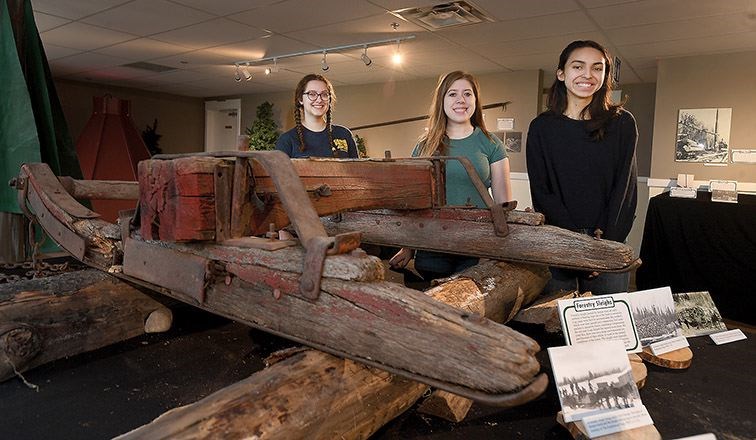There's a student-led exhibit at the Central B.C. Railway and Forestry Museum that focuses on logging and how it impacted the region.
The exhibit is called Forestry in the 20th Century: Changing Technology and its Ecological Impact and will be on display until the end of October when the Celebration of Lights display will take its place in the main room of the museum.
It took two months of research and collecting artifacts and two weeks to physically put it all together, including making a skid road for a forestry sleigh and models of streams and railways, and a miniature beehive burner to speak to the issues of the ecological impact logging had on the area.
"We fashioned a makeshift skid road or corduroy road, which is a road they would have built in the forest so they could transport the logs on sleighs," Neyve Egger, a student at the University of King's College in Halifax, said.
There is a display showcasing logging on a stream.
"It's basically looking at the ways logging or moving logs through vulnerable stream beds affect the environment, including salmon and how it impacted the ecosystem around it," Tehja Orcherton, College of New Caledonia student, said. A part of that display is the component of how the logging industry changed their ways in order to better sustain the environment instead of destroying it, she added.
"Look at our beehive burner," Molly Fandrey, University of Alberta student, said. When visitors crawl inside there's a light at the top of the interior that makes is look like it's burning.
Fandrey was happy to share a recent experience where children had come in from taking a ride on the Cottonwood mini rail train and the route goes through a full-size beehive burner. The children immediately went to explore the miniature version in the museum that was created by student Kathryn Rempel, who was absent from the interview. The children were quick to explain how the beehive burner worked to their grandparents.
Fandrey had a strong reaction to that.
"Yes! Children learning. I'm so proud!"
The display explains how impactful the beehive burner was to the environment and how those in the industry have positively changed the way wood waste is utilized as the City of Prince George now uses a biomass system to heat some of the buildings in the downtown core and at the University of Northern B.C.
There's a video of the whole logging process which includes a look at Eagle Lake Sawmill in 1963, which is a Wally West Production.
"We've also got a display about forestry and the railroad," Fandrey said. "The rail was a huge part of forestry and it ties into why there was so much forestry because as the railroaders built up into Prince George there'd just be sawmills dotted all along the railroad because it was so easy to transport."
It got to the point that logging was so rampant, the government finally put limits on how much logging could be done, Fandrey added.
The students' enthusiasm spread throughout the park and there were many changes made all over the site this summer.
"We were so fortunate to get as many students as we had this year," Katherine Carlson, curator at the museum, said. "It's been a really good summer."
The museum was able to get grants for 12 student workers through Canada Summer Jobs and Young Canada Works to help develop the site, offer guided tours to visitors, help with archiving an extensive inventory as well as create the exhibit to provide education about logging to guests.
For more information about the exhibit visit the museum at 850 River Road or visit www.pgrfm.ca.



